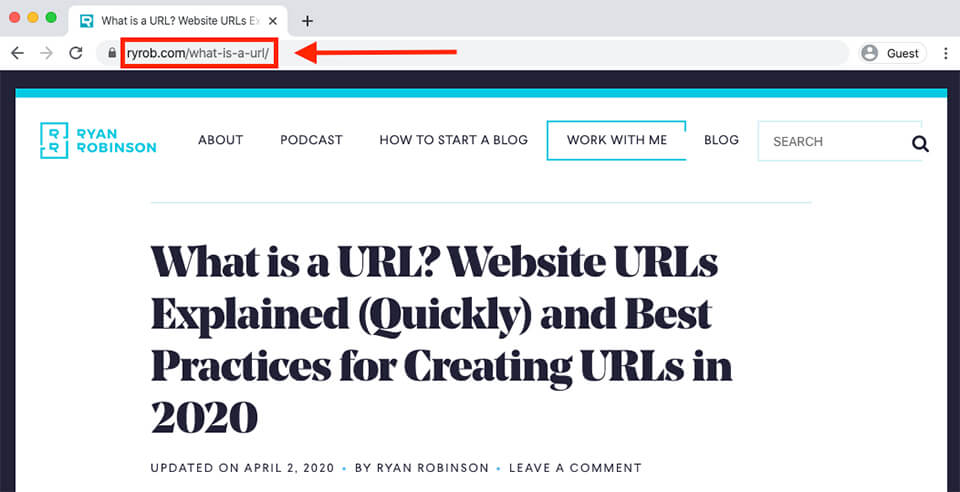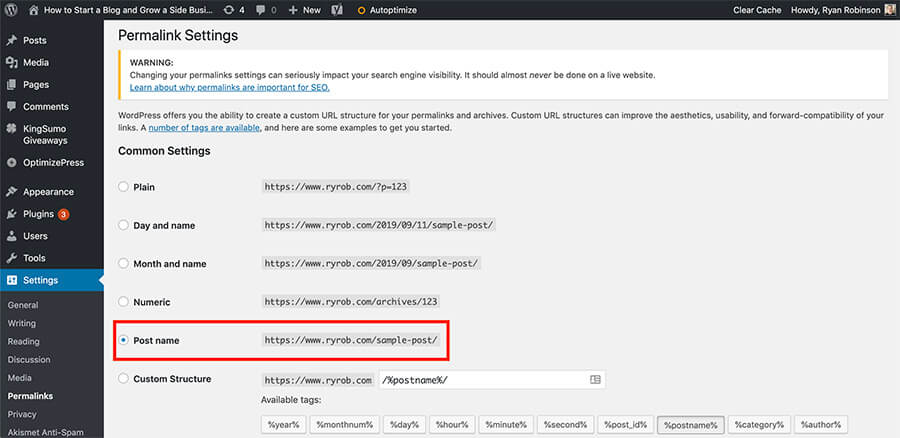We’re here to answer, what is a URL? So, let’s get right to it.
What is a URL?
A website URL (short for Uniform Resource Locator) is the complete address of a web page on the Internet, starting with your domain name and incorporating the full page address. For example, the URL of this web page you’re reading on right now, is https://www.ryrob.com/what-is-a-url/ and it directs your web browser to load the content on this page.
From a more technical perspective, a website URL is a reference to a particular web resource (in most cases, a blog post or page on your website) that specifies its exact location on a server network—and provides the mechanism for retrieving it, in order to visually display the content on your web browser.
Over the years, I’ve been teaching 500,000 monthly readers how to start blogs on the right foot—and one of the questions I almost always field from new bloggers at some point, is how to create URLs that’ll be SEO-friendly and give them the best chance of ranking their content high in organic Google search results one day soon.
So with that framing in mind, let’s talk more about how to create SEO-friendly website URLs for your posts & pages.
What is a URL? Website URLs Explained and Best Practices in 2020
Disclosure: Please note that some of the links below are affiliate links and at no additional cost to you, I’ll earn a commission. When you make a purchase using my one of my affiliate links, the company compensates me, which helps me run this blog and keep my content free of charge to you. Know that I also only recommend products I personally stand behind.
Alright, now let’s talk about best practices for creating SEO-friendly URLs today.
Best Practices for Creating SEO-Friendly Website URLs in 2020
The full URL of your blog post, is what gets crawled by search engines (like Google) and considered for indexing.
Therefore, it’s an important signal for them to figure out what your article is really about. It’s one of your biggest opportunities to include your main target keyword phrase and indicate the main nature of what the page is going to be all about.
In the screenshot above, you’ll see the URL I’ve chosen for this blog post right here. Let’s use this as an example to walk through.
Your Top Level Domain (TLD) vs the URL Path
The first part of the full URL you’ll see in the address bar here (or screenshot directly above) is my Top Level Domain—known as a TLD. That’s the ryrob.com part here on my site, which is more commonly known as your domain name. It’s how every URL on this website begins.
The second part of the full URL you’ll see is known as the “path,” which directs a reader’s web browser to the specific page they’re requesting to load. That’s the /what-is-a-url/ part, which fulfills the browser request to load this content you’re reading right now.
If you’re using WordPress to power your blog—like I recommend to all bloggers—then you have a lot of control over what your default URL paths will look like.
Known as “permalinks,” within your WordPress settings, you can make adjustments to this setting (I recommend choosing “Post name” as the default structure) in your dashboard by navigating to Settings > Permalinks like so:
Now, it’s important to note that not every default URL suggestion will always be perfect right out of the gate.
In most cases, you’ll need to make some adjustments in order to make them SEO-friendly.
What Makes an “SEO-Friendly” URL?
First, you need to start with a clear goal in mind—because not every website URL actually needs a ton of strategy behind it.
So, what’s the primary objective of your post (or page)?
- Is your goal to rank high in organic search results and drive in traffic?
- Is your goal to simply educate existing readers or subscribers with an internal page?
For this article you’re on right now, my goal is to (eventually) rank #1 for the search term, “what is a URL” so that I can drive traffic from the largest search engines—back to this article in order to educate and build relationships with new readers. As a secondary goal, I also want to encourage those readers to make their way elsewhere around my blog, where they can find many more tutorials and subscribe to get my content delivered straight to their inboxes.
If your goal is to get new readers to your page, then your URL needs to be SEO-friendly.
To put it simply, an SEO-friendly URL must contain your target keyword phrase (or a simplified variation of it).
Because I want this article to rank for the search term, “what is a URL,” I’ve made that phrase my exact URL for this post—as you can see in the address bar above, right now.
If you’re not yet sure exactly which keywords (or set of keyword phrases) you want your article to eventually rank for, then pause right here to do some proper keyword research.
Once you’re clear on the keywords you want your post or page to rank for, you can create your SEO-friendly URL. Take these examples from right here on my blog, as a framework for creating your own:
- Target Keyword Phrase: “how to start a blog“ —> URL: ryrob.com/how-start-blog/
- Target Keyword Phrase: “how to make money blogging“ —> URL: ryrob.com/make-money-blogging/
- Target Keyword Phrase: “how to write a blog post“ —> URL: ryrob.com/how-write-blog-post/
- Target Keyword Phrase: “how to name a blog“ —> URL: ryrob.com/how-name-blog/
- Target Keyword Phrase: “how to pick a blog niche“ —> URL: ryrob.com/blog-niche/
- Target Keyword Phrase: “best web hosting plans“ —> URL: ryrob.com/best-web-hosting-plans/
Keep in mind that you want to avoid creating URLs that are either too long (messy and leaves the potential for misinterpretation by search engines)—or too short (runs the risk of not being descriptive enough to search engines and readers alike).
Have a URL-related question?
Ask away in the comments section below and I’ll weigh in with my advice 🙂




Question for you on promoting your URL. Do you recommend creating a Facebook page for your blog? I’m considering it because that’s the only way I can boost my blog post via Facebook. If you do recommend, can you talk about promotion strategies (i.e. do you post your blog posts on your page, then share it to your profile page? How do you suggest gaining traction for a Facebook page, etc.) Or do you just say bag Facebook altogether? Thanks!
Great question, Liz. If you want to create a Facebook page for your blog, with the goal of boosting posts (and driving in some traffic), then I’d say yes that’s a good experiment to at least try out and see if it works well for your audience/type of content and the niche you’re blogging in. Personally though, I haven’t found Facebook to be a great investment (time or financial) for my own blog… having a Facebook Group would be the only exception that I have felt is very worthwhile.
Otherwise, I’d highly recommend reading through these two guides on my blog here that talk specifically about the best ways to promote your blog:
https://www.ryrob.com/drive-traffic-website/
https://www.ryrob.com/how-grow-blog/
Hi I’m Jonathan Rocha I’m looking at this and it looks hard and it makes me nueves when you don’t have much of a clue. I want to tray this but don’t now if it’s posible for me to get going I have no commpiuter and no money. What do you recommend for me . I want to give this lessons a tray and become like you . Can you help me.
Hey Jonathan! Thanks for taking the time to leave a comment here for me. To keep things as simple & easy as possible, I’d recommend that you head over to my step-by-step guide on starting a blog… that’ll point you in the right direction and get you started: https://www.ryrob.com/how-start-blog/
It’s not as easy to start blogging without a computer, to be honest. I’m soon working on a tutorial about what’s possible to do from a blogging perspective using just a mobile phone and without spending any money. Stay tuned for that soon.
A great informative post about website URLs. Virtually all my blog posts are long URL, but now I know that it is better for the URL to be user-friendly and SEO-friendly; short, compact and concise.
Besides, I have a question about internal links.
For example, I write a long-form post A and I link to post B (relevant info) most than once, is there any negative effect of this in terms of SEO and alike? Or is it better to link from A to B only once?
Of course! Glad to help, Tan 🙂
It’s ok to link from post A to post B more than once, especially if it’s an important article you want to drive readers to. I wouldn’t do it more than say ~5 times throughout a long-form article though… you don’t want to make it appear like you’re trying overly hard to push a single link from every article.
Many years ago I took a class on how to bog, but never used it? Can I starting using it now, even though it’s about six years ago! I paid for the coarse and recently found the class information?
Hey Mary, that’s a great question! It depends on who you purchased the course from (and if they regularly update the material). Course content that’s 6 years old might not be 100% relevant to how blogging works today, but a lot of the same principles of creating useful, impactful content for readers and working hard to promote that content still hold true. Check out my recommendations for blogging courses right here: https://www.ryrob.com/blogging-courses/
Hello Ryan,
How to remove the date in the URL?
It looks ugly and it is also not SEO friendly…
Any tips?
absolutely, my friend! you can change your permalinks settings following along with my best practices here (just be sure you also set up redirects from all your old URLs to your new ones): https://www.ryrob.com/what-is-permalink/